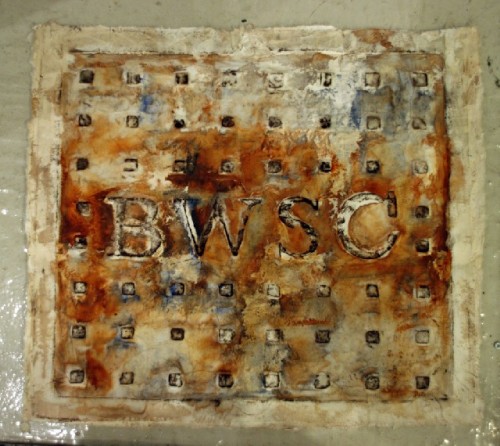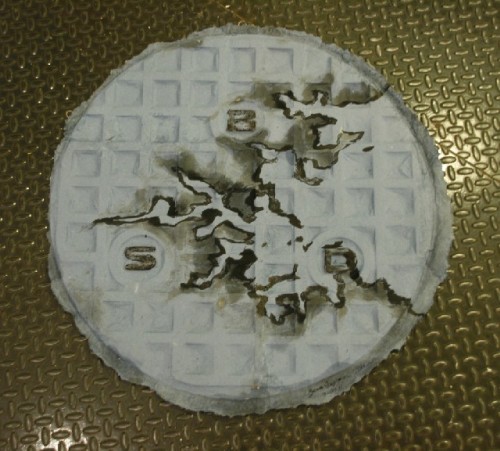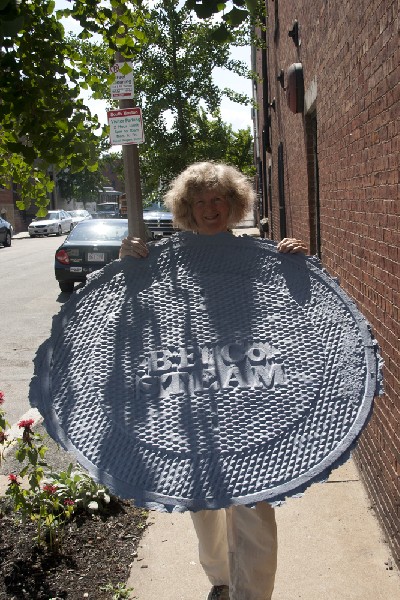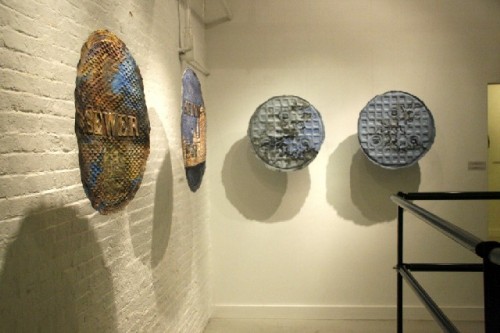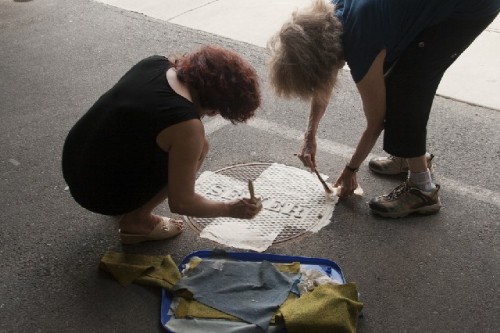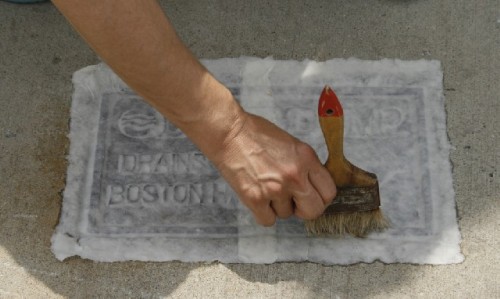Jane Ingram Allen at South Boston Distillery Gallery
Water – Paper – Life
By: Nelida Nassar - Jul 19, 2011
Jane Ingram Allen is an internationally acclaimed, American artist whose environmental projects have been shown in galleries throughout the world. In 2004, she received a Fulbright Scholarship, Artist-in-Residence in Taiwan, where she currently resides. A two-week residency program in South Boston was the inspiration for her current installation: “Boston Don’t Dump.”
Ingram Allen raises our consciousness by drawing our attention to finiteness of resources, the dangers and risks of pollution, and the social and environmental imperatives they create. She uses archaic material nominally paper and papermaking in an age of digital technology. Her archaic practice is not of production value; therefore it is available as an artistic strategy characteristic of revisionist time.
She discusses her project, shedding light on her creative process, techniques, influences and her interaction with the public. The installation is on view until August 16, 2011 at the Distillery Gallery 2nd Street in South Boston.
Nelida Nassar What is the message, or social awareness, you are trying to convey with the “Boston Don’t Dump” project? What is the audience you are trying to reach?
Jand Ingram Allen The message I want people to get is that water is a precious resource and we need to be aware of water pollution and how what we do is all connected, and each person needs to be aware of water sources and keeping them pure. The audience I am trying to reach is more than the usual art audience but lay people, and by doing this project out in public on the streets, more people can be made aware of this environmental issue.
NN Did you focus on any particular manholes and if so why?
JIA I have focused on the Don’t Dump signs because I think they are unique to Boston, and I love the design and the fact that each river or the harbor has a different fish on them. I also used other metal street signs and manhole covers that seemed to have anything to do with water. These manhole covers and signs also help to make people more aware of water issues in the city. I think that artists cannot change the world, but they can change public awareness... by making art with these manhole covers it somehow raises their importance.
NN Why is handmade paper conducive to your project? Can you explain the process?
JIA Handmade paper is biodegradable and made from plant fibers. I use only renewable resources, such as banana leaves and old blue jeans that are made into pulp. Handmade paper can also be used to make the embossed images like castings from the metal street signs. I made handmade paper sheets in blue and white pulp and then pressed the sheets and took them out to put on the manhole covers and street signs to dry. After they dried I removed the handmade paper embossing and took them back to the studio for additional work in mixed media—charcoal, pastel, collage, painting.
NN Can you describe Japanese papermaking and how
it influences your work? How have you adapted the medium to make it your own?
JIA The Japanese style of papermaking is good for this kind of work because it enables you to make thinner but strong sheets by doing multiple dips into the vat and forming the sheets in layers. I use an adapted Japanese technique for the papermaking that is my own combination of techniques I have studied in Japan, Nepal, Brazil, the Philippines, Taiwan and other places and also things I have discovered from experimenting on my own. I think papermaking is a very flexible medium for the artist, and you can make it do what you want. I also enjoy the whole process, and in some ways it is like magic almost... making something out of nothing.
NN What other mediums are you using to create these pieces, and why?
JIA I am using some painting; collage, drawing with charcoal and pastels and thread. I like making the work in layers with imagery on top of the embossed pattern from the manhole covers. I like that people can look at the pieces far away and see one thing and then get closer and see more. I hang the pieces out from the wall without frames so that the viewer is confronted with them more directly and I also like the shadows cast by the pieces hanging in space.
NN Most of the imagery you are incorporating into your art is in a vernacular specific to the city of Boston, what are the elements you have selected to include?
JIA I like making the work very site specific and using what I find in each place to make my work. It all comes from a particular time and a particular place. I even included some trash from the streets in some of the works and what I experienced living in Boston for the two weeks and working in South Boston.
NN You have spent a day teaching teenagers from the Boston area to make paper. What was the experience like? Is it part of your contribution to the community? Have you included any of their artwork in your installation?
JIA The group of teens was the Island Ambassadors and they were great to work with. They seemed to really enjoy the papermaking and getting to know about my work. I wanted to include public participation with this project because by doing, people become even more involved. I
find that making public participation projects and collaborating with other persons is a great way to make contemporary art more comprehensible to the lay population. The kids were great and they made lots of fish for this installation and also several street signs that I used as well.
I consider this sharing with the teens more a mutually beneficial thing as they made some work I could use for the installation, in exchange I hopefully taught them something they can use for future projects on the Boston Harbor Islands. The leaders and the kids were already thinking about what kind of art installation they would make with handmade paper.
NN What was the most rewarding aspect of this project?
JIA I was getting to know Boston better and meeting lots of interesting people in the building and I believe that the day with the teens was the highlight of the project.
NN Your project began in Taipei, Boston’s sister city. Do you intend to extend this project to other cities around the world, making it an international project, not unlike your world map project?
JIA I believe this project could extend to almost any city anywhere in the world. Water is definitely one of the most pressing environmental problems worldwide. And all cities have manhole covers and metal street signs and all are pretty unique that I have seen. I would just have to find a sponsoring gallery or art organization in the city and some interest in helping to sponsor such a project. For this project in Boston I was fortunate to receive a grant from the Puffin Foundation to make it happen.
Because my son Chris Allen and his wife Rebecca live in Boston I was able to stay with them and do it here without the expense of accommodations. The grant helped with materials and equipment and travel. Boston is a sister city to Taipei and I had already done some work in Taiwan during my Fulbright grant in 2004 using the Taipei city manhole covers and street signs. Some of these pieces are also exhibited in the Boston exhibition at Distillery Gallery. It is interesting to compare and contrast the Boston and Taipei pieces.
NN In an age where technology is often an intrinsic part of both making and showing art, your process and installation bypass this trend. The beautiful installation you have created here is all about economy of means. Can you talk about this aspect of your work? And why you select this method of working?
JIA Papermaking is labor intensive and all hands-on in contrast to high tech processes. I am not opposed to technology and use digital photos and computers for research and of course the Internet. I enjoy the fact that paper is inexpensive and recyclable and that even though a simple process, it can be very special.
NN What are the challenges of a two-week residency versus a long-term one?
JIA In a two-week residency you have to be very focused and work very hard.... almost no time for socializing and for getting to know the place.
More time makes the place much more leisurely. I find that I work well under pressure and in some ways an intense period of total concentration can produce amazing things. I think artists will always take as much time as is allowed, and in some ways art is never finished... you look at it again and see something else you might do to it. Longer-term projects can be nice because you can do more research and spend more time on each part of the installation.
NN Do you recommend residencies for artists?
JAI Yes, I would recommend residencies for artists. It is a way to broaden perspectives and cultural exchange is also a great part of it. Residencies are a good way to have the time and place to concentrate on a particular art project. Also, usually you meet interesting people and encounter new ideas as well as new environments.

